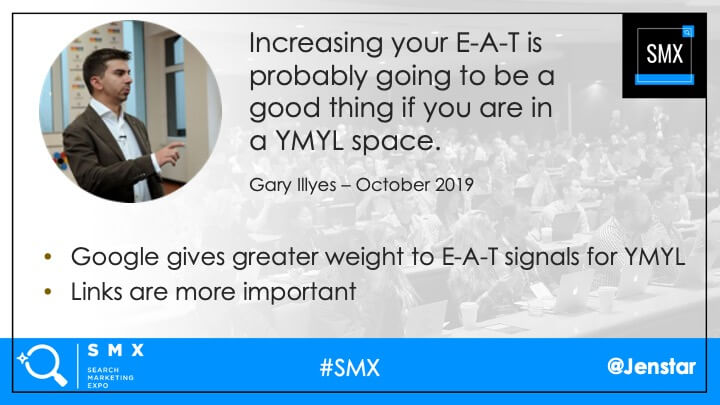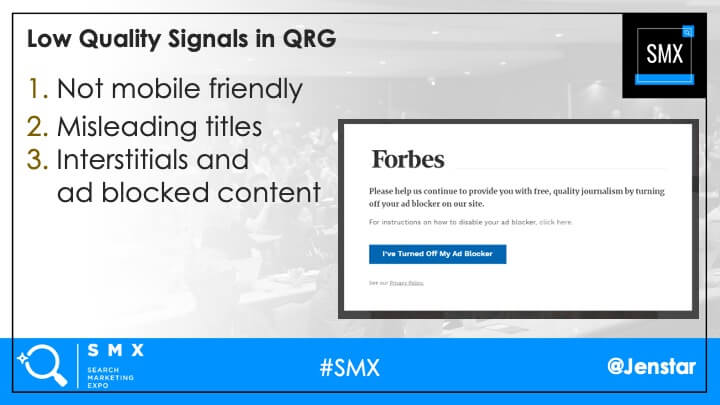A quick guide to understanding Google’s quality rater guidelines
Jennifer Slegg explains the most important themes for brands.
“You can view the rater guidelines as where we want the search algorithm to go,” Ben Gomes, head of search for Google, once explained to CNBC. Gomes’ statement highlights the document’s relationship with Google’s algorithm, yet despite its relevance for publishers and SEOs, the quality rater guidelines (QRG) remain an intimidating resource for many digital marketers.
At SMX West in San Jose, Jennifer Slegg, editor for The SEM Post, discussed how Google views the QRG, what quality raters do, and explained four of the guidelines’ most important themes for publishers.
Quality raters are not SEO professionals and do not know whether algorithm changes that get tested will actually go live. Their feedback helps Google evaluate changes, but doesn’t directly impact rankings. The guidelines exist to help raters assess “Page Quality” and “Needs Met.”
The pillars of Google’s quality rater guidelines
During her presentation, Slegg divided the QRG into four main themes.
Expertise, Authoritativeness, Trustworthiness. Raters assess pages according to the amount of expertise, authoritativeness and trustworthiness of the page’s main content as well as the content’s creator.
Google uses a variety of signals as a proxy to match what humans are looking for, and in that regard, E-A-T is a ranking factor, Slegg said. However, Google does not assign pages an E-A-T score — it is simply a term Google created to teach quality raters what to look for.

“How does Google assess E-A-T? They said that the best-known signal is PageRank — that means links,” Slegg explained. Google may count links from other authoritative sites in your sector as vouching for your page.
“You want to make sure that you’re putting out content that other people will feel good about linking to,” Slegg provided as a rule of thumb. To achieve that standard, Slegg advised that publishers perform thorough research and strive to be the original source.
In addition to amassing backlinks, publishers can bolster their E-A-T by citing their sources, including author bios and credentials, hiring authors that are experts in their field, adding “about” info and contact details and managing their reputation and reviews.
Needs Met. “Needs met” refers to how well your page satisfies the user’s query.

“If you want to get the ‘Fully Meets’ ranking for this, which is the highest ranking you can possibly get, you need to ensure that your content is completely answered what searchers are looking for,” said Slegg.
Diving into your Google Search Console to see what keywords are bringing users to your site and assessing that against your landing pages is one way to improve your needs met ranking. Facilitating your user experience — for example, by having all your content on a single page instead of across numerous pages that force users to click through to the next one — can also decrease the odds that users return to the search results and look for one of your competitors’ listings.
Your Money or Your Life. Content that may potentially affect a person’s future happiness, health, finances or safety are designated as “Your Money or Your Life” (YMYL). Financial or health advice, news, shopping are just a few examples of YMYL topics.
“These types of sites are held up to the highest standard in the Google search results,” Slegg said, adding, “a lot of sites that got hit hard in algorithm updates are YMYL sites because Google is really striving to make sure that only the highest quality pages in the YMYL space are the ones ranking.”

Google wants to send users to trustworthy sites, so accuracy is also a crucial factor for YMYL content. For publishers in the health, science, and historical sectors, there is an especially high standard for accuracy as well as consensus, where such consensus exists. “All raters are required to check content accuracy in order to give a page the ‘Highly Meets’ [the second-highest rating, below ‘Fully Meets’] rating,” Slegg said.
Page quality. Low-quality signals can also ding your pages in the eyes of quality raters. Rater are instructed to assign the lowest rating available to pages that are not mobile-friendly. Misleading or clickbait titles, ad-blocked content and obtrusive ads are all considered low-quality signals.

“Google knows that sites need to have ads to support revenue,” Slegg said, noting, “it’s more about the types of ads.”
Lacking E-A-T, a negative reputation and low-quality content can also prevent you from achieving a higher rating as well as discourage users from viewing your content.
Contributing authors are invited to create content for Search Engine Land and are chosen for their expertise and contribution to the search community. Our contributors work under the oversight of the editorial staff and contributions are checked for quality and relevance to our readers. The opinions they express are their own.
Related stories
New on Search Engine Land